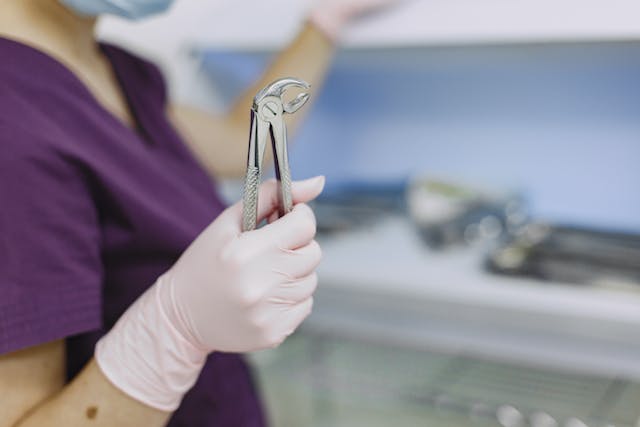Extraction forceps are most needed in dentistry; they are important for safely and effectively removing teeth. Whether for routine extractions or complex surgical procedures, these instruments play a pivotal role in ensuring successful outcomes. Primarily, tooth extraction forceps help grasp and remove the tooth luxated with a dental elevator. So, they come in multiple designs to cater to the requirements of different tooth extraction procedures depending on the jawbone’s anatomy.
Here, we will look at the different extraction dental forceps.
Types of Extraction Forceps
Dental forceps are essential dentistry tools for various procedures, primarily tooth extraction. So, they come in different sizes, each designed for specific teeth or functions.
Here’s a breakdown of the different types of dental forceps:
Universal Forceps
These dentistry tools are designed to accommodate many tooth shapes and sizes, making them suitable for various extraction scenarios. Universal forceps feature beaks with broad, serrated tips to secure grip and minimize slippage during dental extraction.
Upper Anterior Forceps
Specifically crafted to extract upper front teeth, these tooth extraction forceps feature narrow, pointed beaks that can easily access tight spaces and grasp delicate anterior teeth without causing excessive damage to surrounding structures.
Lower Molar Forceps
Designed for the extraction of lower molars, these dentistry tools are characterized by their robust design and angled beaks, which allow for effective engagement with the curved roots of mandibular molars. So, the ergonomic handle design provides efficient extraction.
Pediatric Forceps
Designed for use in pediatric dentistry, these dental extraction forceps are scaled down to accommodate children’s smaller mouths and teeth. The beaks are carefully shaped to ensure gentle yet secure grasping, minimizing discomfort and trauma during extraction procedures.
Structural Components of Extraction Forceps
Understanding the anatomy of dental forceps is essential for their proper use. Generally, these dental tools have the following three structural features:
- Handles: Mostly plier design; provide grip and leverage for the operator
- Beaks: serrated, toothed, angled, designed to grasp the tooth securely
- Joint: Facilitates controlled movement and force application
Selection Criteria for Dental Extraction Forceps

Choosing the appropriate dental surgical instrument is critical in any tooth extraction procedure. The proper selection ensures a safe, efficient, and controlled removal while minimizing trauma to the surrounding tissues.
The choice of forceps depends on various factors, such as:
- Tooth Position and Accessibility: Determines the type and size of forceps required.
- Tooth Root Morphology: Influences the design of the forceps to ensure efficient grip.
- Dentist’s Preference: Certain dentists may have preferences based on their experience and technique.
Procedure for Extraction Using Forceps
Proper Technique
Dentists must employ proper gripping and manipulation techniques to ensure safe and effective extractions. So, this includes positioning the forceps correctly around the tooth and applying controlled pressure to facilitate its removal.
Patient Comfort
Ensuring patient comfort is paramount during dental extractions. Dentists should communicate effectively with patients, addressing any concerns or anxieties they may have and providing appropriate anesthesia to minimize discomfort during the procedure.
Post-extraction Care
Following dentistry tools, patients should receive clear instructions for post-operative care to promote optimal healing and prevent complications such as infection or dry sockets. So, this may include guidelines for pain management, oral hygiene, and dietary restrictions.
Safety Measures and Precautions
To ensure patient safety and successful outcomes, dentists must adhere to strict protocols:
- Patient Positioning: Ensuring proper alignment for optimal access and visibility.
- Operator Technique: Exercising caution to avoid damage to surrounding tissues.
- Post-Operative Care: Providing instructions for aftercare to promote healing and prevent complications.
Maintenance and Sterilization of Extraction Forceps
Proper maintenance and sterilization are crucial to prevent cross-contamination and ensure instrument longevity. Regular cleaning, lubrication, and autoclaving are essential to maintaining dental Surgical instruments.
Emerging Trends in Extraction Dentistry Forceps Technology
Dental technology advancements continue to enhance the functionality and ergonomics of extraction dental forceps. So, these developments aim to optimize performance and patient comfort from improved materials to innovative designs.
Conclusion
Extraction forceps are indispensable tools in dentistry, offering precise and efficient tooth removal for various clinical scenarios. Understanding their anatomy, selection criteria, and proper usage is vital for dental professionals to ensure successful outcomes and patient satisfaction.
If you need any dental forceps, GerDentUSA has them in multiple variations. So, they have been manufacturing and supplying dental surgical instruments over the past three decades.
FAQs
Are extraction tooth forceps only used for removing teeth?
While their primary function is tooth extraction, some forceps are designed for other dental procedures like implant placement.
Can extraction dentistry forceps be reused on multiple patients?
Extraction forceps should be properly sterilized after each use to prevent cross-contamination.
Is anesthesia always necessary for tooth extraction?
Local anesthesia is typically administered to minimize pain and discomfort during the procedure.
Related Post:







